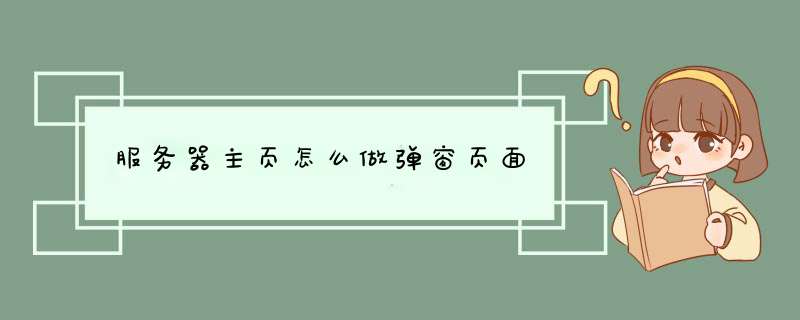
2.勾选了首页弹窗后,点击右方的设置进入到设置模块的界面。
3.然后选择所需的功能添加到右边白色框里,然后调整模块的大小。弹窗背景就是白色框的背景,可以根据个人需求添加。
4.设置好后点击保存,那么网站首页的弹窗就做好了,我们每次进首页都会有弹窗的一个效果,大家可以通过自助建站平台的网站模板实际操作一下,可以多了解弹窗的功能,然后制作一个适合自己网站的弹窗。
后端服务器一般是指servlet容器,用于执行java源程序常见的网页有html,htm,shtml,asp,aspx,php,jsp等格式
前两个常用于静态网页,后面几个常用于动态网页。
这里前端网页以比较常见的 xx.html 和 xx.jsp 网页作为介绍,其它类似
一、静态页面xx.html如何跟后台交互:
先来看一个最简单的登陆界面源代码
user: password: <input type="submit" value="Submit"/>
</form>12
这是一个表单,我们看到里面都是纯html内容,这是一个静态页面,当我们点击submit按钮时候,浏览器会提交表单内的数据到服务器的loginServlet这个相对地址,我们看看浏览器的地址变成啥了:
这不就是我们的后台servlet的地址嘛,然后这个地址指向的是loginServlet这个servlet,然后在web.xml文件中找到这个servlet关联的java类,从而执行了服务器端的程序(第一次执行,那么会实例化,然后执行里面init()函数,然后执行service()函数,如果是第二次调用,那么不用实例化了,直接执行service()函数),我们来看看服务器端的源程序:
package com.atguigu.javaweb
import java.io.IOException
import java.io.PrintWriter
import javax.servlet.Servlet
import javax.servlet.ServletConfig
import javax.servlet.ServletContext
import javax.servlet.ServletException
import javax.servlet.ServletRequest
import javax.servlet.ServletResponse
import javax.servlet.http.HttpServletRequest
public class loginServlet extends MyGeneriServlet {
public void init(javax.servlet.ServletConfig config) throws ServletException{
super.init(config)
}
public void service(ServletRequest request, ServletResponse response)
throws ServletException, IOException {
//获取请求方式是GET,POST方式?
HttpServletRequest httpServletRequest=(HttpServletRequest) request
String method=httpServletRequest.getMethod()
System.out.println(method)
//1.获取请求参数:username,password
String username=request.getParameter(“username”)
String password=request.getParameter(“password”)
//获取请求参数
String initUser=getServletContext().getInitParameter(“user”)
String initpassword=getServletContext().getInitParameter(“password”)
PrintWriter out=response.getWriter()
//3.对比
if(initUser.equals(username)&&initpassword.equals(password)){
out.print("Hello"+username) // 生成html内容
}else{
out.print("Sorry"+username) // 生成html内容
}
}12345678
}
上面没有判断此时对servlet的请求是post还是get方法,不过没关系,request这个传进来的参数以及包含了这些信息,自己判断一下执行相应的操作即可
由于页面路径已经跳转到servlet了,但是servlet不是一个.html文件啊,那岂不是没有内容供浏览器显示了,不是的,我们看到返回的参数response中的对象PrintWriter out用于动态生成html内容的字符串"Hello",所以这时候相当于servlet这个路径也有了html内容了,浏览器的页面就会显示上述字符串了
二、jsp页面如何跟后端服务器交互:
jsp网页文件就是html内容里面插入java代码,当我们访问.jsp网页文件时候,服务器提前已经知道这个页面内含有java代码,那么服务器这边就得先执行一下这些代码(就跟执行servlet的java源代码一样),同时把执行的结果嵌入在当前这个.jsp页面内,我们看看源代码:
<%@page import=“java.util.Date”%>// 如果这个.jsp页面中用到了一些java函数,就得导入库,这就跟java源文件一样的
<% out.println("Hello World!")// 这里实际上是服务器执行了结果,然后以文本返回给浏览器进行显示 %>
上面红色代码就是java代码,刚刚说过对象PrintWriter out用于动态生成html内容的字符串,所以服务器执行完嵌入在里面的java代码后,就是动态生成了一串html代码,然后一起传给客户端浏览器进行显示
当然这种情况.jsp里面没有按钮,表单这样的控件,现在再来看看有表单这种.jsp如何跟后端交互:
view.jsp
<%@page import=“day03_student.Student”%>// 还是得带入java用到的库文件
学生个人基本信息
<% Student s=(Student)request.getAttribute("students")// %>
编号学号姓名性别年龄
<%=s.getId()%> <%=s.getStuno()%> <%=s.getName()%> <%=s.getGender()%> <%=s.getAge() %>
参考的原文:https://blog.csdn.net/myclass1312/article/details/80571867
这时候如果我们直接访问这儿view.jsp文件,应该是没有数据的,因为对象s无法从request对象获取,必须得先给这个request对象赋值才行,即应该从如下servlet路径跳转来view.jsp文件路径才行
public class viewservlet extends HttpServlet {
private StudentDao dao=new StudentDao()
public void doGet(HttpServletRequest request, HttpServletResponse response)
throws ServletException, IOException {
String idstr = request.getParameter("id")
int id = Integer.parseInt(idstr)
//将数据放入request中,传递到页面
Student student=dao.queryById(id)
request.setAttribute("students", student)
request.getRequestDispatcher("view.jsp").forward(request, response) // 这里是从当前页面跳转去哪个页面,同时传递了request, response这两个参数,这时候的request就是有内容的,接下来的view.jsp页面就能获取到内容而且动态生成html内容
}
public void doPost(HttpServletRequest request, HttpServletResponse response)
throws ServletException, IOException {
this.doGet(request, response)
}123456789101112131415
}
总结:每个xx.html文件,xx.jsp文件,servlet响应程序…都是需要在客户端浏览器通过URL来访问的。
xx.jsp文件,servlet响应程序因为含有java源代码,需要服务器电脑先执行一下,.jsp文件中的java代码一般会动态生成一些html内容嵌入在当前.jsp文件里面一起给浏览器显示出来;而servlet中的java代码一般是数据处理功能的,可能会通过request.getRequestDispatcher(“view.jsp”).forward(request, response)
这样的方式跳转到其它有html内容的页面的URL(同时传递处理好的数据过去) 来显示结果
欢迎分享,转载请注明来源:夏雨云

 微信扫一扫
微信扫一扫
 支付宝扫一扫
支付宝扫一扫
评论列表(0条)